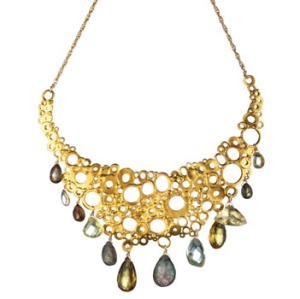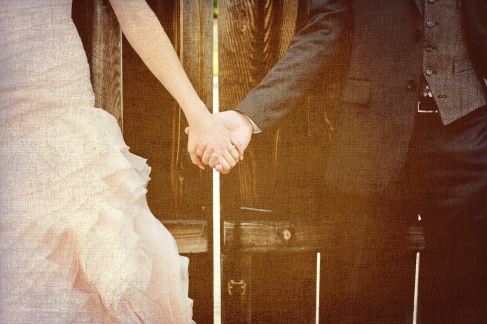
Despite arriving early, it took me ages to find parking and I waited in a line that went out the door only for them to run out of books before I reached the end. Popular lady! Thanks to the zoom button on my phone’s camera I sort of know what she looks like. Adam and Kelly, I was planning to get you signed books for Christmas. This post is for you!
The book was supposed to be written over the final six months of her pregnancy, but it took three years. She said that she put a lot of specifications in the contract with her editor, one that it was to be written in exactly six months, no more, no less. She jokingly refers to the book as her second child, and she reminded the audience that if anyone asks when the second REAL child is coming, she’ll know her mother (in the audience) put them up to it (BUSTED). The reason it took so long was because she’s self-admittedly picky; everything has to be just so. For example, the pages needed to stay open to the recipe that you’re working on. It ended up being so long (350 + pages) because she didn’t want to take away from the text preceding the recipes, because they make a big difference. And she put a lot of thought into what recipes would go into it, and some were taken out and put back in several times, maybe after being tweaked a little.
The blog just celebrated its 6th birthday. If it were a child it would be attending kindergarten and starting to talk back. She went to university and graduate school in Washington D.C. (and yes, she had a bigger kitchen then, but it never got any use), and had tons of crappy jobs before quitting her day-job to blog full time. She has been a swimming instructor, art therapist, scrawler of “Happy Birthday” on cakes, barista, etc… Six years ago she quit her day job as an IT (something I’ve never heard of) which was boring, not worth mentioning, and she says she was bad at it.
The blog came about when she wanted to make a birthday cake for her friend. She wanted it to be just so: the vanilla flavor needed to be present, the cake needed to be just the right light density, fluffy yet moist, etc. And she thought there should be a go-to recipe for such a thing. And the results on Google were just too overwhelming; if she and friend spent every day testing 3 recipes out of the Google results, they might achieve an analysis after a lifetime of research, providing they still had all their teeth. She liked a lot of food blogs, and they all had a specific approach, a niche to fill, and she just liked to cook. She didn’t feel like she had a “theme” to work with.
The name Smitten Kitchen: she doesn’t even know what it’s supposed to mean. But she was drawn to the duality of “smitten”, containing the meanings of the past tense of “to smite” as in god smiting you, and “smitten” in the sweet sense, like being in love. That combination of sweet and evil is what she liked. So back to the birthday cake. She kept trying different recipes, but each on was “too x” or “not y enough”. She had in her mind this specific idea of a cake and it had to be just so. That is her process: she gets something in her head and she needs to make it. It might come from a dish that she tried at a restaurant, whether it was perfect and she wants to streamline it, or if it wasn’t what she expected and she wants to create exactly what she had in mind.
When she was asked what her favorite restaurant was, she said that her answer was sad because it just closed. It was a modern Indian restaurant with yummy perfect veggie dishes, and unfortunately Manhattan didn’t seem to be ready for it. But there were some in the running. When asked what her favorite recipe was, she said it was like being asked if you have a favorite child. But right now she and her family really love roast chicken with olives and grapes. Also it depends on the season, like right now she loves the cider caramel because they taste like fall. And she loves stuffing so much that she thinks it’s a shame that stuffing/dressing is mostly limited to Thanksgiving. One of her next recipes is going to be a “breakfast stuffing”.
Someone asked what her son would remember her by in terms of food, and she quickly responded with “APPLESAUCE!” He eats it by the gallon. But that it’s not really a recipe. She is thrilled that his favorite food right now is her broccoli fritters and how exciting it is that her 3-year-old likes a vegetable, and it’s green. She said, no, she didn’t bring him with her on the trip and he was most likely doing beer and football with dad at this very moment. She had spoken with him earlier on the phone and he said he had eaten broccoli, but that was doubtful and they were definitely doing beer and football.
She was asked if there’s any ingredient she didn’t like to use, and without hesitation she said “BEETS! I hate BEETS!”. She continued to explain that “It’s not so much the taste, but, I don’t know, they’re so RED and… leaky”. Everyone’s got their food aversions, even if they’re famous chefs. Emeril can’t stand dill, and Rachel ray just can’t get over her dislike of honey. She also doesn’t really like fish. But she tries to overcome these aversions; she did a roasted beets recipe that she loved, and she combined them with other veggies and some olive oil and salt and pepper. As for fish she did halibut, which she liked, halibut is the “gateway fish”. The fish aversion isn’t a kosher thing—she’s not religious and she has intellectual beef with the kosher laws. For her, food is clean if it’s produced ethically and sustainably. She describes herself as a terrible Jew because her favorite things are pork and shellfish. She loves the traditions (but especially the foods, like challah) of Judaism.
She alluded several times to being extremely picky. She doesn’t seem like a difficult person though- she’s extremely good-natured. She has a bright and young energy, and she’s pleasantly childlike without being childish. She was extremely humbled, expressing shock that the huge crowd had come just to see her.
The questions turned to her process once more, and these days she drops her son off at preschool, where they sell coffee, which she thinks is the best idea ever. So she walks home with a giant coffee and enjoys the quiet, remarking that it feels odd to say that Manhattan is quiet, but somehow it’s true at that moment. And afterwards she has her most productive hours.
As for the photography, she stole her husband’s camera on her honeymoon in 2005 and hasn’t returned it yet. It’s fancy and has a ton of buttons that she doesn’t use. To her a photograph is good if it communicates what you intended. Specifically when it comes to food she wants to show what onions look like when they’re chopped, or the color of a fruit or vegetable. Oh, and natural light is by far the best. Her kitchen is tiny, and if she had her choice of kitchens, the most important thing would be to have a window. She loves her tiny kitchen and she’s not crazy; she wouldn’t turn down a bigger kitchen, but kitchens are just small in Manhattan, and she loves Manhattan.
P.S. My favorite things by Deb:
World Peace/Korova cookies: The answer to any chocolate emergency, and my Husband’s current favorite. If he didn’t eat them at the rate he does (One in each hand. And he’s still skinny. I told him that everyone WISHES they had his problems), I would gain thirty pounds.
Jacked Up Banana Bread: As long as you cross out the “optional” in front of bourbon in the recipe. I added walnuts because I was curious; my Mom hates nuts baked into things so I’m deprived.
Buttermilk Roast Chicken: Perfection. Even though I use skinless breasts because my weirdo Husband doesn’t like bones and skin or dark meat. I make it with mashed potatoes and add the chicken juices in. My mashed potatoes embody perfection, but adding the juices take them to another level.
Plum Ricotta Crepes: A real hit at my friend’s regular crepe parties
One last thing: My brother made her granola crusted nuts for a friend as a gift, but ended up eating them all because they’re addictive as crack. I believe him. He’s probably made more by Deb than I have, and his cooking skills blow me away. I don’t have that “thing” that makes me a food artist like my Mom and Brother.
Okay, last thing, I swear: I really can’t take credit for finding the Korova cookies or the Plum Ricotta Crepes– my BFF Kelly clued me into those.
And much, much more. WE LOVE YOU DEB!!!










